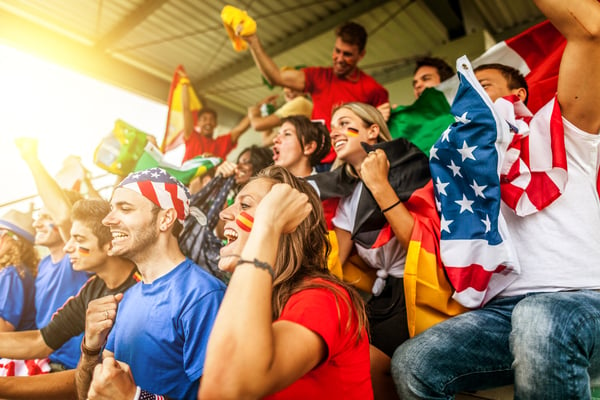CEO Blog - Advice for CEOs on growth and scaling
What Can CEOs Learn from the Business of Sports?

In times when our world is divided, one thing tends to be a “great unifier”—the spectacle of athletic competition. Across the globe, sports inspires us, gives us hope, makes us healthier, breaks our hearts and, ultimately, brings us together. Though most fans care about how their player or team performs in the field of play, away from the field, the business of sports has been in disruption. How sports organizations are addressing these newfound challenges provides a road-map for fundamental lessons that can help a CEO in any business gain growth-oriented insights.
In a series of blogs, I will lead you through the high level challenges shaking the foundation of the business of sports, and offer some frameworks and ideas to address them. My goal is to build on conversations that are already taking place—and, perhaps, start some new ones.
In this first blog, I hope to provide some context for our discussion. Let’s start with looking at what’s been happening:
Tossed around like hot potatoes—M&As, exits and demises
A great starting point for understanding why the sports business is under such assault is to look at what’s happening to the business of America’s favorite pastime, baseball. Many of the companies which supply the game with its bats, balls and gloves are as revered, and time-tested, as the game itself. But an uptick in M&A activity has left no sacred cows.
Rawlings, arguably the brand most associated with America’s favorite past time, changed ownership in 2018 for the fourth time in the last fifteen years in a PE-led deal. Amer Sports, owner of the Wilson and Louisville Slugger brands, is facing a takeover bid from the Chinese giant Anta. Louisville was sold to Wilson only three years ago.
Other sporting goods brands are experiencing the same tumult. In just the past half-decade, we also witnessed the sale of brands like Easton, Taylor Made and many more. There are also the pure exits and demises, like Nike exiting golf equipment and brands like Bike ceasing to exist in 2017, 11 years after becoming part of Berkshire Hathaway as part of Russell Athletic acquisition.
So, one wonders, why these well-known, heritage brands can’t seem to earn lasting love from their owners?
Brutal competition for market share in no-growth markets
According to the Sports and Fitness Industry Association, the top industry challenge in recent years has been to find a way to increase market share while competing in no-growth markets. Simply, many sports have not seen significant increases in participation, which is a key measure of their main customer base. For those still participating, there has been a shift from serious athlete to casual athlete—a group considered to be less likely to spend money on premium brands. Golf participation has been particularly hit, with rounds played continuing to decline.
For some reason, our love for sports is not translating to sales and profits for our beloved brands.
Increasing marketing costs
While industry executives are focused on how to increase market share, marketing costs associated with that effort are on the rise. Sponsorship revenues of professional leagues over the last decade have skyrocketed. Sponsorship of individual pro athletes, state adoption costs and other legacy marketing spend areas have all seen significant increases. These increases negatively impact both small and large brands. Under Armour, which had announced in 2016 that it would be the official supplier of MLB uniforms, recently had to back out of that deal, relinquishing the rights to Nike.
Increased marketing cost—without the matching increase in sales—puts industry profits under immense pressure.
Seismic shifts in retail channels
Flat markets, coupled with the overall disruption of retail by the growth of eCommerce, has led to seismic shifts in sales channels for sports equipment. During the 2010s, we’ve witnessed the bankruptcy of Golfsmith and The Sports Authority, along with the acquisition of Golf Galaxy by Dick’s Sporting Goods. BSN Sports continues its neck-breaking speed of acquisitions to consolidate the team dealer channel. Finish Line gave up on its effort to consolidate independent running specialty channel under the Jack Rabbit banner. Bigger and stronger retailers tend to focus on fewer national brands, while prioritizing private label brands.
In such a fluid environment, sports brands are forced to deal with conflicts between the needs of old and new channels, as well as with their own growth goals.
The new consumer—Millennials, Gen Z
The environment that led to the successes of Nike starting in the 1980s and Under Armour in the 1990s no longer exists. The core consumer of today’s sports brands—Millennials and Gen Z—grew up in a world that shaped them very differently than previous generations. This has created both challenges and opportunities. These groups tend to be hard to reach through marketing; they have less discretionary income; and their values are different.
This raises a key question: How do you make your brand meaningful to today’s digitally native, globally connected, Uber-riding, and constantly multi-tasking consumer, without losing your brand identity?
What can be done?
In future blog posts, I will be writing about how sports brands can deal with this very tough business environment, and still drive profitable growth. We know strong brands can command higher margins, drive loyalty and earn more forgiveness from consumers. Therefore, I will be using a basic framework for brand building:
- Be authentic and consistent
Trust for brands, just like for people, is built if what you say, and what you do, are aligned. How can brands that play in the emotionally rich space of sports better execute their marketing playbook to deliver consistent and authentic customer experiences to drive growth?
- Stay relevant
Coaches and athletes spend lots of time analyzing their performance, their competitors—anything and everything that can help their performance. Even professionals at the top of their game get coaches to sharpen their skills and learn new ones. How can sports brands and organizations build an insights engine, then act on what is learned, to demonstrate an understanding of their consumers’ deep motivations?
- Make life better
An active lifestyle makes us healthier, happier, and more at peace, yet many pain points still exist. As evidence of this truism, ask any golfer about his or her swing. How can brands tap into the global trends and the intrinsic values of sports, to bring meaningfully new product or service innovation to world?
I look forward to exploring these areas in the near future. If you’d like to participate in the discussion, I’d love to hear from you.
Topics: Business Leadership and Strategy, CEO Business Strategy, Fitness & Entertainment
Tue, Mar 5, 2019Featured Chief Outsider

Ahmet Abaci
Related Articles

- Press Releases
- Careers
- Case Studies
- Marketing Consultant Company
- Marketing Strategy Consultants
- Marketing Plan Consultants
- B2B Marketing Consultants
- Virtual CMO
- Marketing Consultant Outsourcing
- Fractional CMO
- What is a Fractional CMO
- Healthcare Marketing Consultant
- Marketing Consultant Houston TX Texas
- Marketing Consultant Texas TX
- Marketing Consultant Bay Area
- CEO Blog
- Ebooks Plus
- Executive Marketing Consultants
- Product Marketing Consultants
- B2C Marketing Consultants
- Virtual Marketing Consultants
- Senior Marketing Consultants
- Temporary CMO
- Hire a CMO
- Fractional CMO Salary
- Fractional CMO Responsibilities
- Marketing Consultant Austin TX Texas
- Marketing Consultant Dallas TX Texas
- Marketing Consultant San Antonio
- Helping Private Equity
- Private Equity Blog
- Leadership Team
- Privacy Policy
- Business Marketing Consultants
- Strategic Marketing Consultants
- Marketing Technology Consultants
- Sales and Marketing Consultants
- CMO Job Description
- CMO Salary
- Fractional CMO Agency
- Fractional CMO Services
- CPG Marketing Consultant
- Marketing Consultant San Diego
- Partners
Houston, TX 77056
© 2023 Chief Outsiders


